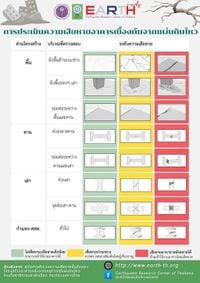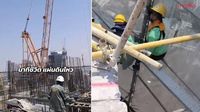On March 28, 2025, a powerful earthquake measuring 8.2 on the Richter scale struck near Papua New Guinea, sending tremors that reverberated across Thailand, particularly affecting the northern regions and the bustling capital of Bangkok. This seismic event raised immediate concerns about the structural integrity of buildings in the affected areas, prompting a swift response from government officials.
In the heart of Bangkok, a dramatic scene unfolded as construction workers on a high-rise building faced the terrifying reality of the earthquake. TikTok user @boommmm98 captured the moment, posting a video that showed workers scrambling for safety as the building swayed violently, and cranes swung precariously overhead. "This is a life-or-death moment; everyone is running for their lives. Luckily, we hadn't gone up to the rooftop yet," the user wrote, sharing the harrowing experience with their followers.
The video quickly gained traction on social media, with many viewers commenting on the workers' quick thinking and the importance of remaining calm during such emergencies. One viewer remarked, "This is a good lesson; when unusual events occur, securing the crane first is crucial before evacuating from vulnerable spots." The incident highlighted the dangers faced by construction workers who often operate at great heights in precarious conditions.
In response to the earthquake, Anutin Charnvirakul, Thailand's Deputy Prime Minister and Minister of Interior, addressed the public's concerns about building safety. He stated, "The earthquake has caused anxiety among citizens regarding the stability of their residences and workplaces. We must ensure these structures can withstand seismic events." Anutin announced that his ministry would establish a center to receive public complaints and inspect buildings potentially impacted by the earthquake.
The Disaster Prevention Center has been actively assessing the damage caused by the earthquake, with a focus on structural integrity, including floors, beams, columns, and reinforced concrete walls. Anutin emphasized that if any buildings were found to be at risk, immediate corrective action would be mandated to ensure public safety.
"We will open channels for citizens to submit requests for inspections. If weaknesses are identified, we will expedite repairs. Moreover, we will make inspection results publicly available to keep residents informed and alleviate their concerns," he added. This proactive approach aims to reassure the public that their safety is the government’s top priority.
As the assessment continues, the National Earthquake Research Center has reported that while the earthquake's epicenter was located in Papua New Guinea, the tremors felt in Thailand were strong enough to cause significant concern. The center has been monitoring the situation closely, providing updates on the potential for aftershocks and advising citizens on safety measures.
Experts have noted that the earthquake serves as a stark reminder of the importance of earthquake preparedness in a region that, while not typically known for seismic activity, is not entirely immune to such natural disasters. The incident has sparked discussions about building codes and safety regulations, particularly in urban areas like Bangkok where high-rise construction is prevalent.
In light of the event, many residents are beginning to question the safety of their own homes and workplaces. Some have expressed frustration over the perceived lack of rigorous building inspections and standards. "We need to feel safe in our homes, especially in a city where so many buildings are going up so quickly," said one concerned citizen.
The government’s swift response is crucial in maintaining public confidence. Anutin assured citizens that all necessary measures would be taken to ensure the structural integrity of buildings across the country. "If any building is found to be unsafe and necessary repairs are not made, we will enforce penalties according to the law," he stated firmly.
As the dust settles from the earthquake, the focus now shifts to recovery and prevention. The government’s commitment to inspecting buildings and addressing public concerns will be key in the coming days. With the potential for aftershocks looming, residents are urged to remain vigilant and prepared.
This incident has not only highlighted the vulnerabilities of urban infrastructure but also the resilience of the community. As workers on construction sites demonstrate their ability to act quickly in emergencies, the public is reminded of the importance of preparedness and safety in everyday life.
Ultimately, the earthquake serves as a wake-up call for many, emphasizing the need for ongoing education about earthquake safety and preparedness. As Thailand moves forward, the lessons learned from this event will undoubtedly shape future policies and practices regarding building safety and disaster response.






